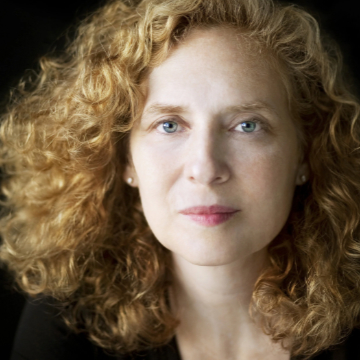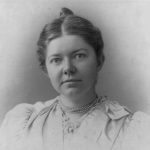September 20 & 21(m), 2025
Jones Hall
Houston, Texas – USA
Houston Symphony, Juraj Valčuha, conductor; Angel Blue, soprano; Houston Symphony Chorus, Anthony J. Maglione, director; Houston Chamber Choir, Betsy Cook Weber, artistic director.
Julia WOLFE: Liberty Bell (Houston Symphony co-commission, world premiere)
Florent SCHMITT: Psalm 47 (1904)
Igor STRAVINSKY: Suite from The Firebird (1945 version)
Lawrence Wheeler | 23 SEP 2025
Saturday evening, Houston Symphony music director Juraj Valčuha led the second of three concerts at Jones Hall featuring soprano Angel Blue. Valčuha likes to begin each season with the combined forces of the Houston Symphony and Chorus. The Friday night Gala performance did not include the world premiere of Liberty Bell by Julia Wolfe.

Julia Wolfe (credit: Peter Serling)
Julia Wolfe is one of the most frequently and widely performed contemporary composers. The recipient of the Pulitzer Prize in Music and a MacArthur Fellowship, her pieces address social and political subjects, such as climate change, equal rights for women, and the plight of garment workers and coal miners. Liberty Bell was written to commemorate the 250th anniversary of the United States. Wolfe calls it “raucous and loud…Obtaining liberty is not a quiet, tidy process. It is a messy, boisterous, ongoing, interlocking struggle.” The bell was cast with the lettering “Proclaim LIBERTY Throughout all the Land unto all the Inhabitants Thereof”– an inscription that Wolfe takes literally.
At the beginning, Wolfe uses metal chimes and pitched bell plates to create loud, repetitive sounds while the orchestra plays syncopated rhythms. Played at the volume of a rock concert, the noise goes on for some time. High horns screech and low brass punctuate the texture. Extensive use of percussion, including a drum set, adds to the clamor. There are random pauses with 4 or 5 hits on the bell plates. After a big crescendo, thunderous noise is made on large metal sheets. While this may represent the struggle to obtain liberty, I waited in vain for one consonant chord where the bell sounded true and clear.
As with many contemporary pieces, Liberty Bell is more cinematic than formally based. Wolfe grew up in a small town north of Philadelphia. She likely rode the Paoli Local, the same train Charles Ives rode into Philadelphia while composing. I took that train every Saturday to my violin lessons and to play in the Philadelphia Youth Orchestra. At times, this piece reminded me of that train, with the clatter of cars and wheels. But I always knew I was headed to Penn Station one way and home the other. It may be that Wolfe sees our quest for liberty as a work in progress, with this piece serving to keep us mindful and knock us out of complacency.
Valčuha is a master at conducting new pieces. He was precise with beats and cues, showing serious commitment to the music. The orchestra responded with a stellar, if loud, performance.
French composer Florent Schmitt was born in 1870 and lived to age 87. Composed in 1904, Psalm 47 places Schmitt in the pantheon of great French choral composers, the heir to Berlioz. It is a grandiose work, with the massive operatic grandeur of Massenet set in a concert hall. Praised by Ravel as profound and powerful, it contains jubilant proclamations and tender expressions. Stylistically, it has elements of French Impressionism, the exoticism of Rimsky-Korsakov, and post-Wagner orchestrations with a French accent.
The Houston Symphony Chorus was joined by the Houston Chamber Choir to assemble the required large chorus. Anthony J. Maglione made his Houston Symphony debut as director, succeeding Betsy Cook Weber, who is now the artistic director of the Houston Chamber Choir. The combined forces sang admirably, both in a fugue begun by individual sections and in unison. Much of the singing involves shouts of praise and glory to God, and these were delivered with energy and sufficient volume. But there were some balance issues where the orchestra covered the chorus in softer passages.

Angel Blue (angeljoyblue.com)
The featured soloist was soprano Angel Blue, making her Houston Symphony debut following a cancellation last November. The soprano solo section, in which the soloist repeatedly sings “From God alone cometh my salvation, He alone is my rock and my defense,” is a marked contrast to the forceful choral parts before and after. Blue carefully modulated the dynamics, slowly building to a glorious climax with radiant power and purity of tone. She effortlessly soared over the orchestra and provided a highlight of the evening.
Valčuha led a dynamic and cohesive performance with his customary attention to detail. Brass fanfares, timpani and percussion, dual harps, and organ added to the festive nature of the thick and rich orchestration. An extensive violin solo preceded and then joined the soprano solo. It was expertly played by concertmaster Yoonshin Song, but did not sufficiently stand out, as marked.
The audience responded enthusiastically to the inspiring performance of the Schmitt. During the bows, it seemed odd to see Maglione enter the stage ahead of Betsy Weber and Angel Blue.
Written in 1910, just six years after Psalm 47, Stravinsky’s Firebird is one of the most celebrated works in the classical repertoire. Stravinsky created three versions of the Suite—in 1911, 1919, and 1945, the version used here. It has 10 parts (although the concert program listed only nine). He made changes to articulation and the order of movements from the popular 1919 version, but the only instrumental change was the addition of a snare drum. While Stravinsky admired Schmitt’s work, he took a different track with orchestration. Rather than recreating the lush string sounds of the 19th century, Stravinsky focused on the woodwind section, along with more varied percussion. Consequently, most solos are played by woodwinds. The excellent woodwind section was outstanding across the board—each solo was like opening a box of bonbons. Flute, oboe, clarinet, bassoon, and French horn were beautiful.
While allowing for some freedom in the wind solos, at times Valčuha drove the orchestra. The Infernal Dance was faster than the indicated tempo of 152. Reports are that Friday was even faster. While the piccolo and upper strings’ ricochets and spiccatos were clear, I am not certain what the point is when the inherently visceral pulse is compressed. After “Katschei,” the lovely “Berceuse” led to the triumphant “Finale.” The concert is the beginning of an exciting season.
The Houston Symphony just announced that Valčuha’s contract has been extended for another three years. It is expected that his work on improving the high standard of the Houston Symphony will continue. It is hoped that, along with technical growth, there will be commensurate growth in musical goals. Individual players can provide creativity and stellar musicianship, but an orchestra consists of more than stars. Those times when everyone feels valued and included have resulted in the best performances. Perfection in music is elusive, if even necessary. What is paramount is the quest for an ideal, the struggle to provide meaning through artistic expression. As the ultimate music teacher, a conductor leads a body of musicians by providing a cohesive interpretation. It is a collaborative effort—inspired performances are the result of diligent preparation and committed execution going both ways. ■
EXTERNAL LINKS:
- Houston Symphony: houstonsymphony.org
- Juraj Valčuha: jurajvalcuha.com
- Angel Blue: angeljoyblue.com
- Houston Symphony Chorus: houstonsymphony.org/about-us/chorus
- Houston Chamber Choir: houstonchamberchoir.org

Read more by Lawrence Wheeler.







.png)